Customer-Centric, Two-Product Split Delivery Vehicle Routing Problem under Consideration of Weighted Customer Waiting Time in Power Industry
Abstract
:1. Introduction
2. Literature Review
2.1. Split Delivery Vehicle Routing Problem
2.2. Vehicle Routing Problem Considering Customer Satisfaction
3. Problem Description and the Mathematical Model
3.1. Problem Description
3.2. Basic Mathematical Model
3.3. The CTSDVRP Model
4. Customized Hybrid Ant Colony-Genetic Algorithm
5. Case Study
5.1. Background and Data
5.2. Numerical Results
5.3. Sensitivity Analysis
6. Conclusions
Author Contributions
Funding
Institutional Review Board Statement
Informed Consent Statement
Data Availability Statement
Conflicts of Interest
References
- CEO Says Volkswagen Has ‘Seen the Worst’ of the Chip Shortage. Available online: https://edition.cnn.com/2021/10/28/cars/volkswagen-chip-shortage/index.html (accessed on 28 October 2021).
- Manufacturing PMI® at 60.8%. Available online: https://www.ismworld.org/supply-management-news-and-reports/reports/ism-report-onbusiness/pmi/october/ (accessed on 1 November 2021).
- Rieck, J.; Ehrenberg, C.; Zimmermann, J. Many-to-many location-routing with inter-hub transport and multi-commodity pickup-and-delivery. Eur. J. Oper. Res. 2014, 236, 863–878. [Google Scholar] [CrossRef]
- Martínez-Salazar, I.; Angel-Bello, F.; Alvarez, A. A customer-centric routing problem with multiple trips of a single vehicle. J. Oper. Res. Soc. 2015, 66, 1312–1323. [Google Scholar] [CrossRef]
- Moshref-Javadi, M.; Lee, S. The customer-centric, multi-commodity vehicle routing problem with split delivery. Exp. Syst. Appl. 2016, 56, 335–348. [Google Scholar] [CrossRef]
- Oltra-Badenes, R.; Gil-Gomez, H.; Guerola-Navarro, V.; Vicedo, P. Is It Possible to Manage the Product Recovery Processes in an ERP? Analysis of Functional Needs. Sustainability 2019, 11, 4380. [Google Scholar] [CrossRef] [Green Version]
- Dror, M.; Trudeau, P. Savings by Split Delivery Routing. Transp. Sci. 1989, 23, 141–145. [Google Scholar] [CrossRef]
- Archetti, C.; Speranza, M.G. Vehicle routing problems with split deliveries. Int. Trans. Oper. Res. 2012, 19, 3–22. [Google Scholar] [CrossRef]
- Ho, S.; Haugland, D. A tabu search heuristic for the vehicle routing problem with time windows and split deliveries. Comput. Oper. Res. 2004, 31, 1947–1964. [Google Scholar] [CrossRef]
- Salani, M.; Vacca, I. Branch and price for the vehicle routing problem with discrete split deliveries and time windows. Eur. J. Oper. Res. 2011, 213, 470–477. [Google Scholar] [CrossRef] [Green Version]
- Luo, Z.; Qin, H.; Zhu, W.; Lim, A. Branch and price and cut for the split-delivery vehicle routing problem with time windows and linear weight related cost. Transp. Sci. 2016, 51, 668–687. [Google Scholar] [CrossRef]
- Khodabandeh, E.; Bai, L.; Heragu, S.S.; Evans, G.W.; Elrod, T.; Shirkness, M. Modelling and solution of a large-scale vehicle routing problem at GE appliances and lighting. Int. J. Prod. Res. 2017, 55, 1100–1116. [Google Scholar] [CrossRef]
- Fu, Z.; Liu, W.; Qiu, M. A Tabu Search Algorithm for the Vehicle Routing Problem with Soft Time Windows and Split Deliveries by Order. Chin. J. Manag. Sci. 2017, 25, 78–86. [Google Scholar]
- Li, J.; Qin, H.; Baldacci, R.; Zhu, W. Branch-and-price-and-cut for the synchronized vehicle routing problem with split delivery, proportional service time and multiple time windows. Transp. Res. Part E Logist. Transp. Rev. 2020, 140, 101955. [Google Scholar] [CrossRef]
- Lwspay, H.; Suchan, K. A case study of consistent vehicle routing problem with time windows. Int. Trans. Oper. Res. 2021, 28, 1135–1163. [Google Scholar] [CrossRef]
- Chan, F.T.S.; Shekhar, P.; Tiwari, M.K. Dynamic scheduling of oil tankers with splitting of cargo at pickup and delivery locations: A Multi-objective Ant Colony-based approach. Int. J. Prod. Res. 2014, 52, 7436–7453. [Google Scholar] [CrossRef]
- Qiu, M.; Fu, Z.; Eglese, R.; Tang, Q. A Tabu Search algorithm for the vehicle routing problem with discrete split deliveries and pickups. Comput. Oper. Res. 2018, 100, 102–116. [Google Scholar] [CrossRef] [Green Version]
- Gschwind, T.; Bianchessi, N.; Irnich, S. Stabilized branch-price-and-cut for the commodity-constrained split delivery vehicle routing problem. Eur. J. Oper. Res. 2019, 278, 91–104. [Google Scholar] [CrossRef] [Green Version]
- Fazi, S.; Fransoo, J.C.; Woensel, T.V.; Dong, J.X. A variant of the split vehicle routing problem with simultaneous deliveries and pickups for inland container shipping in dry-port based systems. Transp. Res. Part E Logist. Transp. Rev. 2020, 142, 102057. [Google Scholar] [CrossRef]
- Wolnger, D.; Salazar-Gonzalez, J. The Pickup and Delivery Problem with Split Loads and Transshipments: A Branch-and-Cut Solution Approach. Eur. J. Oper. Res. 2021, 289, 470–484. [Google Scholar] [CrossRef]
- Zhang, Z.; Cheang, B.; Li, C.; Lim, A. Multi-commodity demand fulfillment via simultaneous pickup and delivery for a fast fashion retailer. Comput. Oper. Res. 2019, 103, 81–96. [Google Scholar] [CrossRef]
- Tavakkoli-Moghaddam, R.; Safaei, N.; Kah, M.; Rabbani, M. A New Capacitated Vehicle Routing Problem with Split Service for Minimizing Fleet Cost by Simulated Annealing. J. Frankl. Inst. 2007, 344, 406–425. [Google Scholar] [CrossRef]
- Belfioreab, P.; Yoshizaki, H. Scatter search for a real-life heterogeneous fleet vehicle routing problem with time windows and split deliveries in Brazil. Eur. J. Oper. Res. 2009, 199, 750–758. [Google Scholar] [CrossRef]
- Hertz, A.; Uldry, M.; Widmer, M. Integer linear programming models for a cement delivery problem. Eur. J. Oper. Res. 2012, 222, 623–631. [Google Scholar] [CrossRef]
- Yousefikhoshbakht, M.; Didehvar, F.; Rahmati, F. Solving the heterogeneous fixed fleet open vehicle routing problem by a combined metaheuristic algorithm. Int. J. Prod. Res. 2014, 52, 2565–2575. [Google Scholar] [CrossRef]
- Wang, L.; Kinable, J.; Woensel, T. The fuel replenishment problem: A split-delivery multi-compartment vehicle routing problem with multiple trips. Comput. Oper. Res. 2021, 118, 104904. [Google Scholar] [CrossRef]
- Gulczynski, D.; Golden, B.; Wasil, E. The split delivery vehicle routing problem with minimum delivery amounts. Transp. Res. Part E Logist. Transp. Rev. 2010, 46, 612–626. [Google Scholar] [CrossRef]
- Han, F.; Chu, Y. A multi-start heuristic approach for the split-delivery vehicle routing problem with minimum delivery amounts. Transp. Res. Part E Logist. Transp. Rev. 2016, 88, 11–31. [Google Scholar] [CrossRef]
- Xiong, Y.; Gulczynski, D.; Kleitman, D.; Golden, B.; Wasil, E. A worst-case analysis for the split delivery vehicle routing problem with minimum delivery amounts. Optim. Lett. 2013, 7, 1597–1609. [Google Scholar] [CrossRef]
- Nucamendi, S.; Cardona-Valdes, Y.; Acosta, A. Minimizing customer’s waiting time in a vehicle routing problem with unit demands. J. Comput. Syst. Sci. Int. 2015, 54, 866–881. [Google Scholar] [CrossRef]
- Huang, Y.; Yang, Q.; Li, Q.; Zhang, W. The delivery vehicle scheduling considering agents’ perception satisfaction toward waiting time. Ind. Eng. J. 2017, 4, 35–40. [Google Scholar]
- Wu, B.; Shao, J.; Fang, Y. Research on open vehicle routing problem based on satisfaction of customers. Comput. Eng. 2009, 35, 193–194. [Google Scholar]
- Fan, J. The vehicle routing problem with simultaneous pickup and delivery considering customer satisfaction. Oper. Res. Manag. Sci. 2011, 20, 60–64. [Google Scholar]
- Zhang, H.; Zhang, Q.; Ma, L.; Zhang, Z. A hybrid ant colony optimization algorithm for a multi-objective vehicle routing problem with flexible time windows. Inform. Sci. 2019, 490, 166–190. [Google Scholar] [CrossRef]
- Yu, J.; Cheng, W.; Wu, Y. Path planning of fresh takeout considering customer satisfaction. Ind. Eng. Manag. 2021, 26, 158–167. [Google Scholar]
- Chen, J.; Fan, T.; Pan, F. Urban delivery of fresh products with total deterioration value. Int. J. Prod. Res. 2021, 7, 2218–2228. [Google Scholar] [CrossRef]
- Luan, J.; Yao, Z.; Zhao, F.; Song, X. A novel method to solve supplier selection problem: Hybrid algorithm of genetic algorithm and ant colony optimization. Math. Comput. Simulat. 2019, 156, 294–309. [Google Scholar] [CrossRef]
- Peng, P.; Zhang, G. Improvement and simulation of ant colony algorithm based on genetic gene. Comput. Eng. Appl. 2010, 46, 43–45. [Google Scholar]

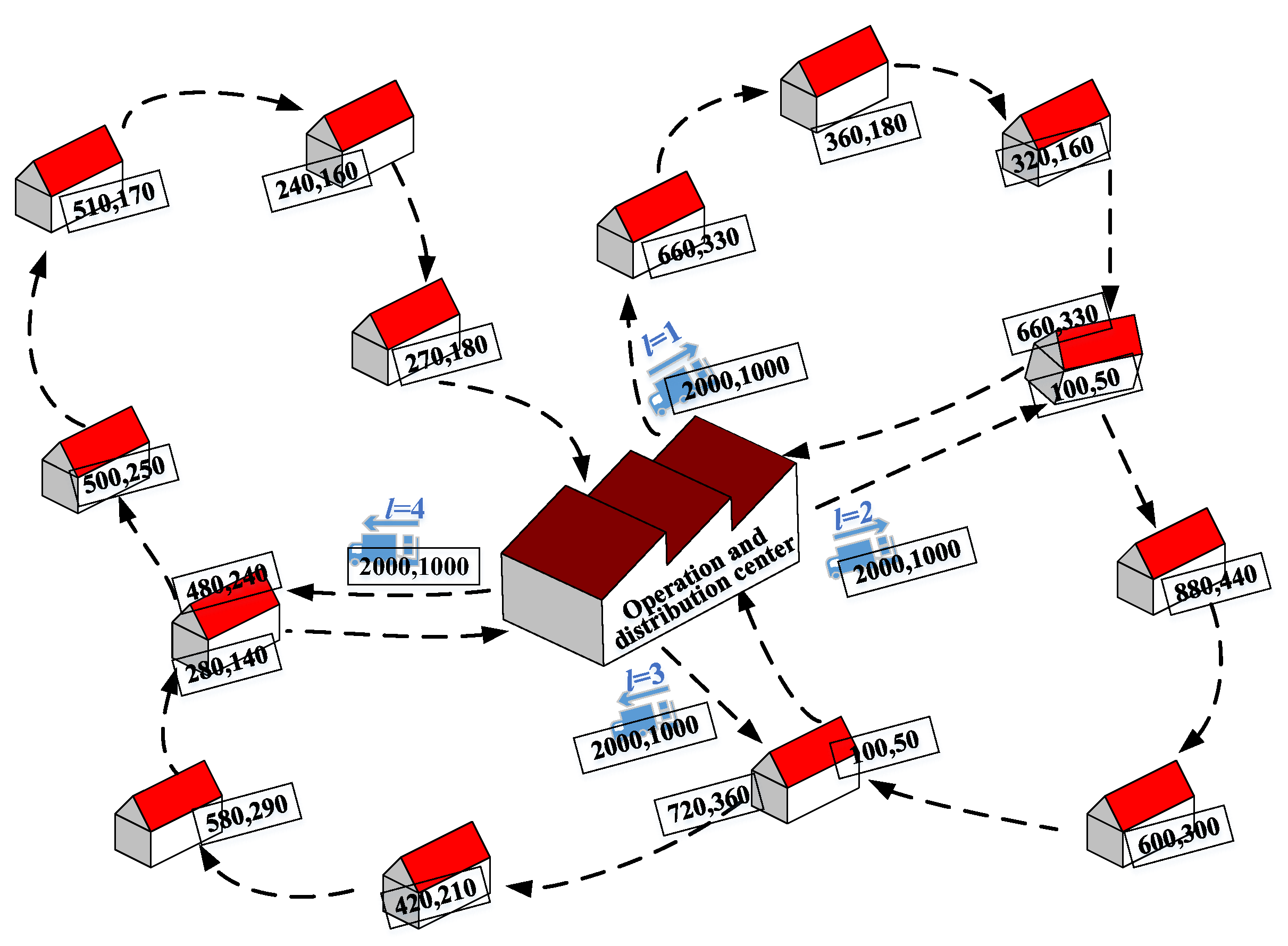

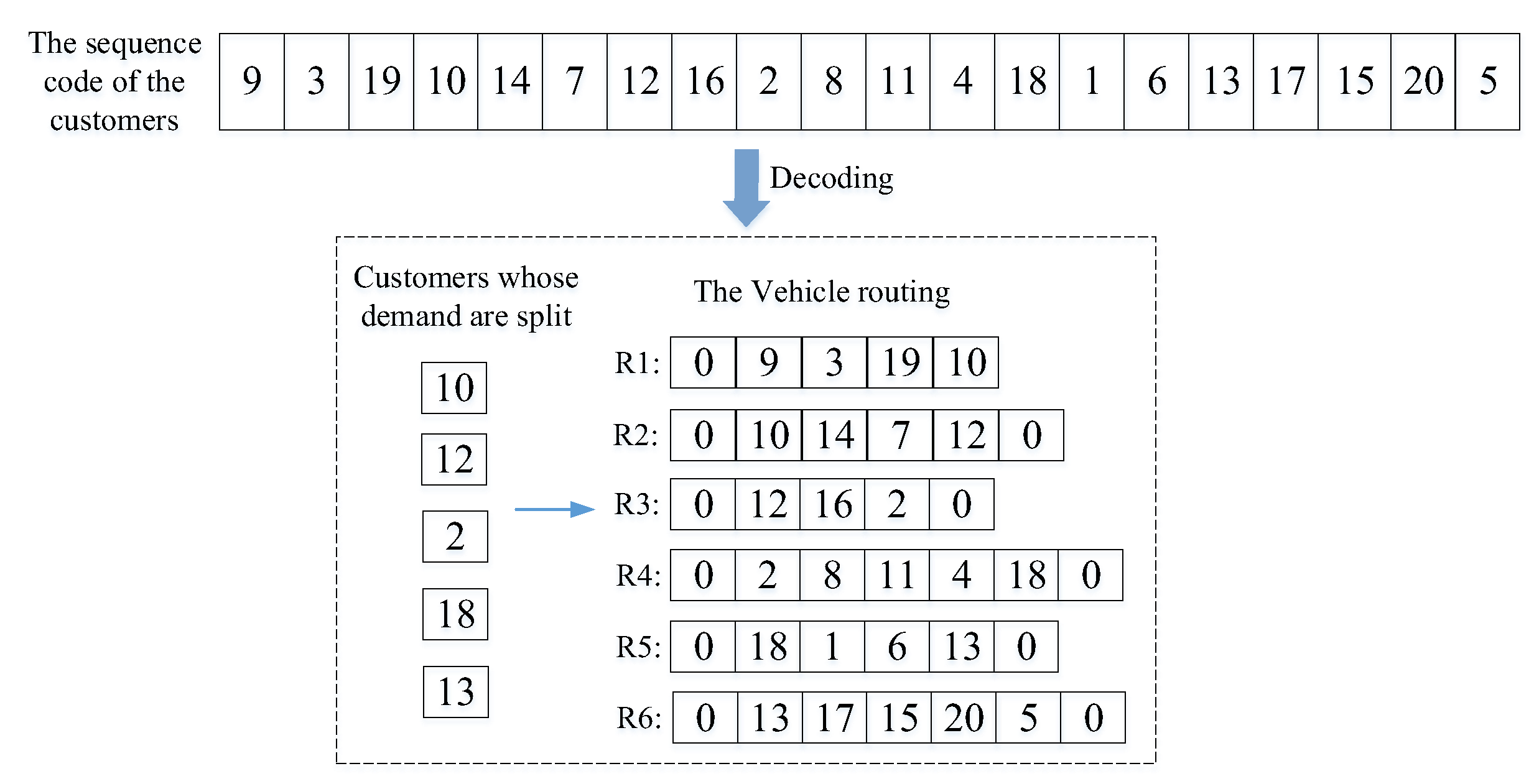
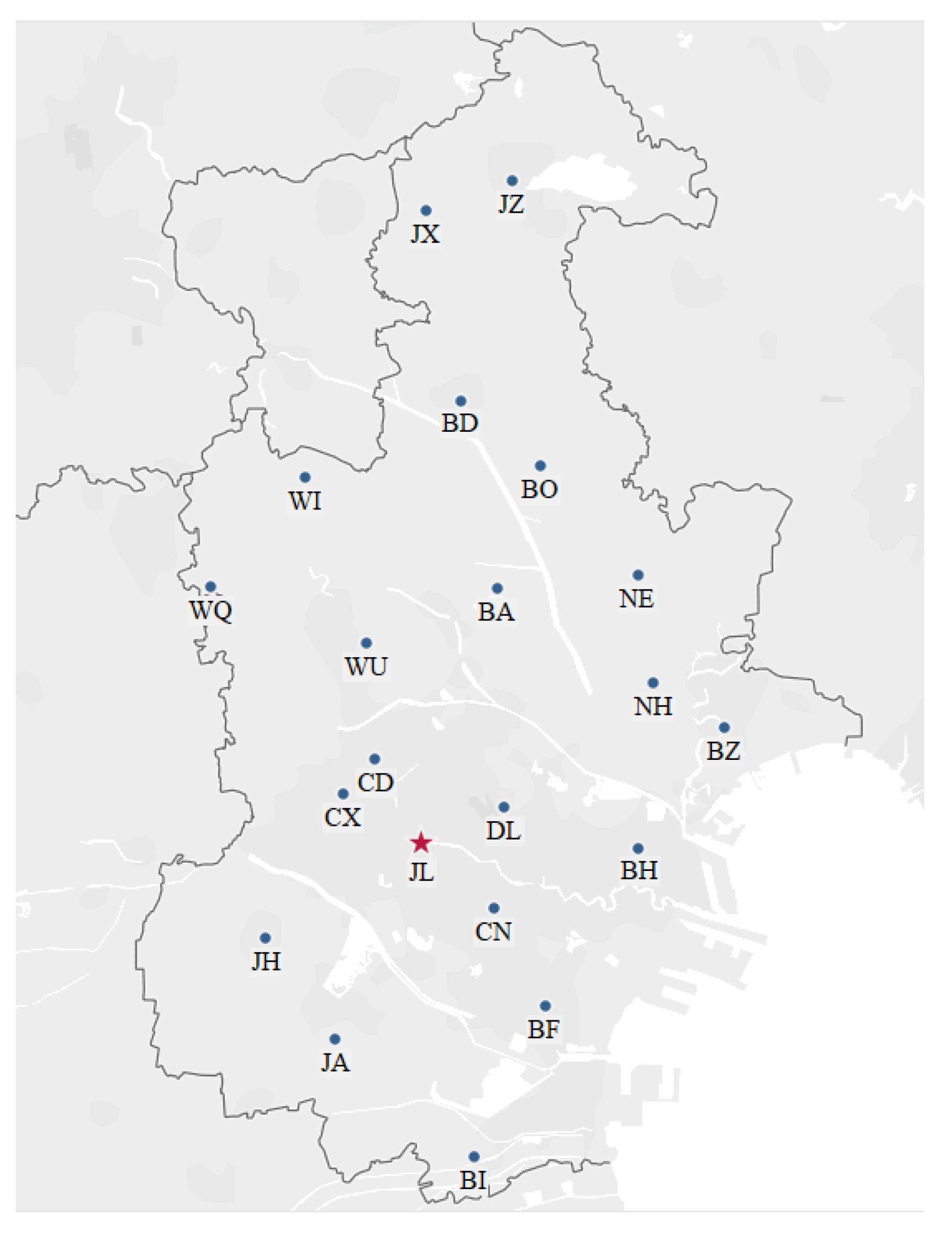



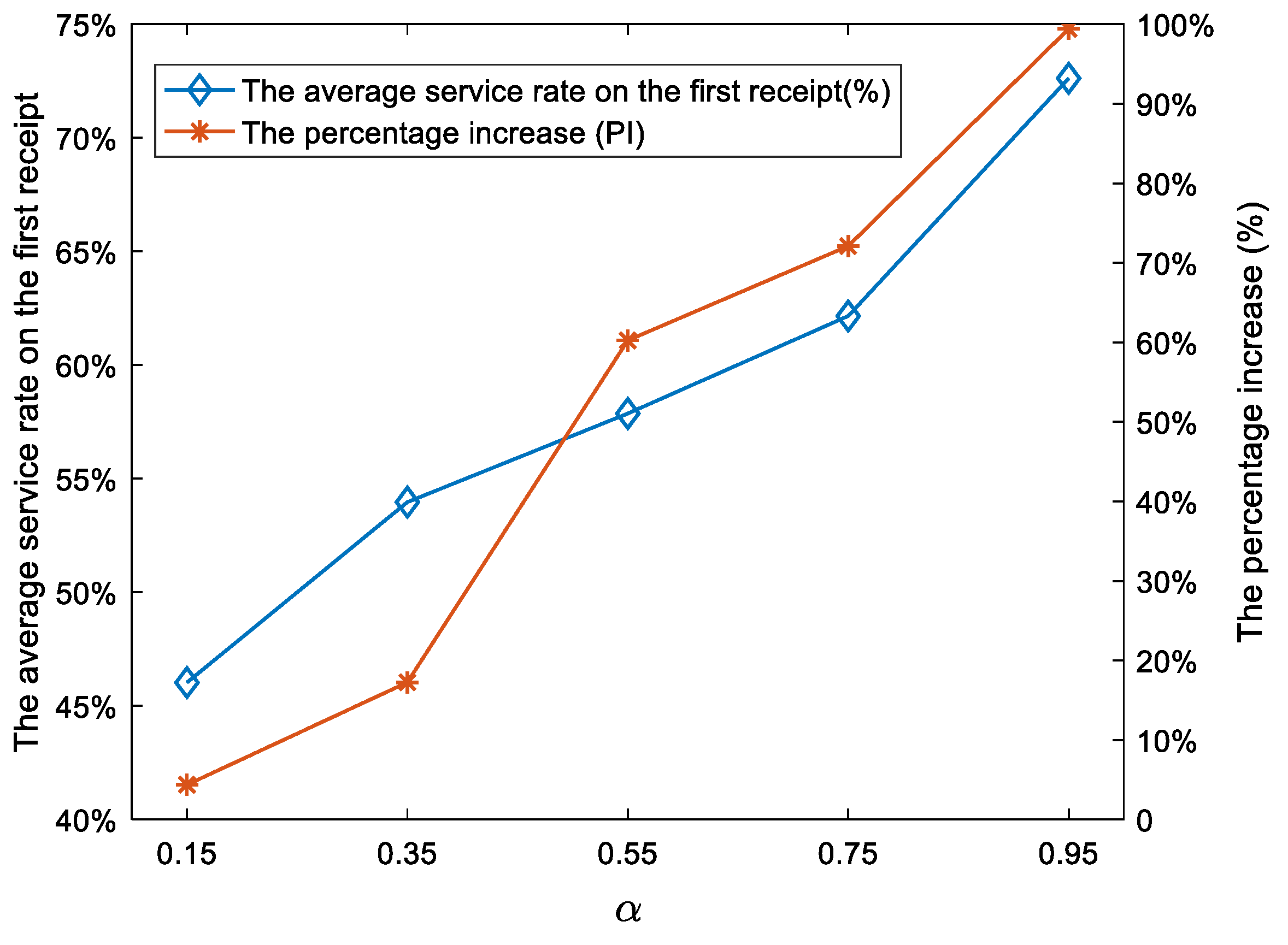
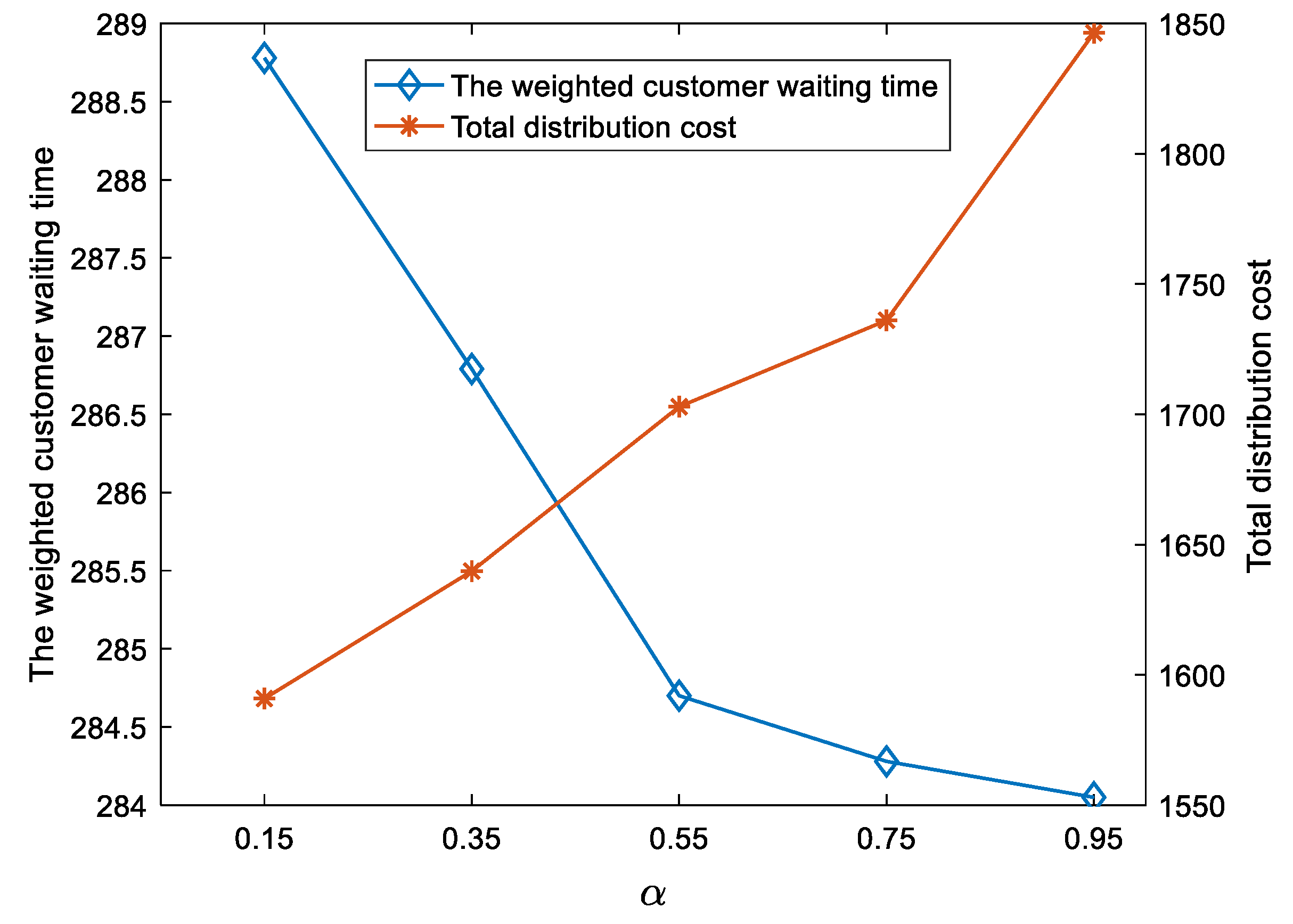
| Author | Multi-Products | Distribution Cost Objective | Customer Satisfaction Objective | ||
|---|---|---|---|---|---|
| Total Travel Cost | Other Costs | Customer Waiting Time | Weighted Customer Waiting Time | ||
| Ho et al. [9] | √ | √ | |||
| Salani et al. [10] | √ | ||||
| Luo et al. [11] | √ | ||||
| Fu et al. [13] | √ | √ | |||
| Li et al. [14] | √ | ||||
| Lespay et al. [15] | √ | ||||
| Qiu et al. [17] | √ | ||||
| Wolfinger et al. [20] | √ | ||||
| Zhang et al. [21] | √ | √ | |||
| Gschwind et al. [18] | √ | √ | |||
| Tavakkoli et al. [22] | √ | √ | |||
| Belfiore et al. [23] | √ | ||||
| Wang et al. [26] | √ | ||||
| Hertz et al. [24] | √ | √ | |||
| Han et al. [28] | √ | ||||
| Nucamendi et al. [30] | √ | ||||
| Martínez et al. [4] | √ | ||||
| Moshref et al. [5] | √ | √ | |||
| Huang et al. [31] | √ | √ | |||
| Wu et al. [32] | √ | ||||
| Fan [33] | √ | ||||
| Zhang et al. [34] | √ | ||||
| Yu et al. [35] | √ | √ | |||
| This paper | √ | √ | √ | √ | |
| Parameters | |
|---|---|
| , | Customer i’s demand for Product 1 and Product 2 |
| a | The capacity of vehicles |
| f | The fixed cost of vehicles |
| Per-unit distance variable cost of vehicles | |
| C | The unit loss cost of customer waiting time |
| The moment at which the vehicle leaves the central warehouse for the lth delivery | |
| Travel time from customer i to customer j for the lth delivery | |
| The earliest moment at which the customer i can receive service | |
| The service time at customer i for the lth delivery | |
| M | Large positive constant |
| The weight of the customer satisfaction, . | |
| Decision Variables | |
| Binary variable; 1, if the vehicle travels from customer i to j for the lth delivery; 0, otherwise | |
| The moment at which the vehicle arrives at customer i for the lth delivery | |
| The quantity of Product 1 delivered to customer i for the lth delivery | |
| The quantity of Product 2 delivered to customer i for the lth delivery | |
| Customer | Demands | Inventories | ||
|---|---|---|---|---|
| A | B | A | B | |
| CD | 186 | 100 | 30 | 8 |
| CX | 65 | 45 | 25 | 15 |
| CN | 175 | 129 | 35 | 11 |
| DL | 135 | 50 | 30 | 5 |
| BD | 728 | 368 | 22 | 7 |
| BA | 102 | 58 | 38 | 12 |
| BO | 84 | 59 | 56 | 11 |
| BH | 189 | 146 | 42 | 8 |
| BF | 261 | 99 | 36 | 0 |
| BZ | 658 | 325 | 6 | 7 |
| BI | 279 | 167 | 0 | 19 |
| JZ | 206 | 66 | 34 | 14 |
| JX | 124 | 58 | 40 | 24 |
| JH | 522 | 278 | 34 | 0 |
| JA | 476 | 156 | 10 | 6 |
| NH | 228 | 71 | 12 | 9 |
| NE | 399 | 258 | 27 | 26 |
| WQ | 257 | 142 | 53 | 13 |
| WU | 658 | 271 | 155 | 0 |
| WI | 268 | 154 | 60 | 10 |
| JL | CD | CX | CN | DL | BD | BA | BO | BH | BF | BZ | |
|---|---|---|---|---|---|---|---|---|---|---|---|
| JL | 0 | 15 | 15 | 16 | 14 | 71 | 43 | 63 | 35 | 33 | 52 |
| CD | 15 | 0 | 8 | 31 | 22 | 59 | 34 | 54 | 45 | 48 | 56 |
| CX | 15 | 8 | 0 | 31 | 26 | 66 | 41 | 61 | 49 | 47 | 62 |
| CN | 16 | 31 | 31 | 0 | 17 | 82 | 52 | 72 | 25 | 18 | 47 |
| DL | 14 | 22 | 26 | 17 | 0 | 66 | 35 | 55 | 23 | 33 | 38 |
| BD | 71 | 59 | 66 | 82 | 66 | 0 | 31 | 17 | 77 | 98 | 67 |
| BA | 43 | 34 | 41 | 52 | 35 | 31 | 0 | 21 | 48 | 68 | 43 |
| BO | 63 | 54 | 61 | 72 | 55 | 17 | 21 | 0 | 63 | 87 | 51 |
| BH | 35 | 45 | 49 | 25 | 23 | 77 | 48 | 63 | 0 | 30 | 24 |
| BF | 33 | 48 | 47 | 18 | 33 | 98 | 68 | 87 | 30 | 0 | 54 |
| BZ | 52 | 56 | 62 | 47 | 38 | 67 | 43 | 51 | 24 | 54 | 0 |
| BI | 52 | 66 | 63 | 40 | 57 | 122 | 92 | 112 | 57 | 27 | 80 |
| JZ | 107 | 95 | 102 | 117 | 100 | 36 | 65 | 46 | 109 | 133 | 94 |
| JX | 101 | 88 | 94 | 113 | 96 | 31 | 61 | 45 | 108 | 129 | 96 |
| JH | 30 | 34 | 26 | 37 | 44 | 92 | 68 | 88 | 62 | 46 | 81 |
| JA | 35 | 46 | 40 | 33 | 46 | 105 | 77 | 98 | 58 | 34 | 80 |
| NH | 45 | 46 | 53 | 45 | 31 | 55 | 29 | 39 | 27 | 55 | 14 |
| NE | 55 | 52 | 59 | 58 | 43 | 40 | 23 | 23 | 44 | 71 | 28 |
| WQ | 53 | 38 | 39 | 69 | 59 | 50 | 46 | 56 | 81 | 87 | 86 |
| WU | 33 | 19 | 24 | 47 | 34 | 42 | 23 | 40 | 55 | 65 | 59 |
| WI | 62 | 47 | 51 | 76 | 62 | 28 | 36 | 38 | 80 | 93 | 78 |
| BI | JZ | JX | JH | JA | NH | NE | WQ | WU | WI | |
|---|---|---|---|---|---|---|---|---|---|---|
| JL | 52 | 107 | 101 | 30 | 35 | 45 | 55 | 53 | 33 | 62 |
| CD | 66 | 95 | 88 | 34 | 46 | 46 | 52 | 38 | 19 | 47 |
| CX | 63 | 102 | 94 | 26 | 40 | 53 | 59 | 39 | 24 | 51 |
| CN | 40 | 117 | 113 | 37 | 33 | 45 | 58 | 69 | 47 | 76 |
| DL | 57 | 100 | 96 | 44 | 46 | 31 | 43 | 59 | 34 | 62 |
| BD | 122 | 36 | 31 | 92 | 105 | 55 | 40 | 50 | 42 | 28 |
| BA | 92 | 65 | 61 | 68 | 77 | 29 | 23 | 46 | 23 | 36 |
| BO | 112 | 46 | 45 | 88 | 98 | 39 | 23 | 56 | 40 | 38 |
| BH | 57 | 109 | 108 | 62 | 58 | 27 | 44 | 81 | 55 | 80 |
| BF | 27 | 133 | 129 | 46 | 34 | 55 | 71 | 87 | 65 | 93 |
| BZ | 80 | 94 | 96 | 81 | 80 | 14 | 28 | 86 | 59 | 78 |
| BI | 0 | 157 | 153 | 49 | 30 | 82 | 98 | 101 | 85 | 113 |
| JZ | 157 | 0 | 14 | 128 | 141 | 83 | 66 | 81 | 78 | 58 |
| JX | 153 | 14 | 0 | 120 | 134 | 84 | 67 | 69 | 70 | 47 |
| JH | 49 | 128 | 120 | 0 | 20 | 75 | 84 | 57 | 50 | 74 |
| JA | 30 | 141 | 134 | 20 | 0 | 77 | 89 | 76 | 64 | 90 |
| NH | 82 | 83 | 84 | 75 | 77 | 0 | 17 | 73 | 47 | 65 |
| NE | 98 | 66 | 67 | 84 | 89 | 17 | 0 | 69 | 45 | 56 |
| WQ | 101 | 81 | 69 | 57 | 76 | 73 | 69 | 0 | 27 | 23 |
| WU | 85 | 78 | 70 | 50 | 64 | 47 | 45 | 27 | 0 | 28 |
| WI | 113 | 58 | 47 | 74 | 90 | 65 | 56 | 23 | 28 | 0 |
| l | Route ID | Distribution Cost | The Customer Waiting Time | Weighted Customer Waiting Time |
|---|---|---|---|---|
| 1 | R1 | 389.18 | 47.21 | 40.36 |
| 2 | R2 | 316.29 | 48.03 | 44.93 |
| 3 | R3 | 353.6 | 60.57 | 55.66 |
| 4 | R4 | 237.94 | 49.78 | 47.1 |
| 5 | R5 | 258.62 | 64.11 | 58.49 |
| 6 | R6 | 290.75 | 41.15 | 37.51 |
| Total | 1846.38 | 310.85 | 284.05 | |
| l | Route ID | Distribution Cost | The Customer Waiting Time | Weighted Customer Waiting Time |
|---|---|---|---|---|
| 1 | R1 | 392.36 | 47.22 | 40.4 |
| 2 | R2 | 270.01 | 47.54 | 45.55 |
| 3 | R3 | 308.05 | 57.97 | 53.26 |
| 4 | R4 | 242.71 | 50.85 | 50.32 |
| 5 | R5 | 341.02 | 66.02 | 62.4 |
| 6 | R6 | 235.59 | 39.13 | 36.54 |
| Total | 1789.73 | 308.72 | 288.47 | |
| l | Route ID | Distribution Cost | The Customer Waiting Time | Weighted Customer Waiting Time |
|---|---|---|---|---|
| 1 | R1 | 395.93 | 48.87 | 41.85 |
| 2 | R2 | 325.26 | 50.45 | 46.84 |
| 3 | R3 | 224.92 | 54.16 | 52.64 |
| 4 | R4 | 318.45 | 77.45 | 71.03 |
| 5 | R5 | 285.96 | 39.63 | 35.55 |
| 6 | R6 | 252.28 | 39.49 | 36.72 |
| Total | 1802.8 | 310.04 | 284.63 | |
| Number of Nodes | Algorithm | CPU (s) | ||||
|---|---|---|---|---|---|---|
| 20 | Hybrid algorithm | 10,886.32 | 310.85 | 284.05 | 1846.38 | 21.74 |
| GA | 10,933.70 | 311.51 | 285.19 | 1931.69 | 20.12 | |
| ACO | 12,633.82 | 364.94 | 329.57 | 2204.81 | 30.08 | |
| 40 | Hybrid algorithm | 38,145.69 | 1070.61 | 1000.03 | 2890.74 | 51.06 |
| GA | 38,214.76 | 1072.73 | 1001.81 | 2918.01 | 54.71 | |
| ACO | 46,738.13 | 1333.73 | 1224.76 | 3947.14 | 70.45 | |
| 60 | Hybrid algorithm | 83,674.52 | 2321.58 | 2195.66 | 4790.83 | 98.22 |
| GA | 83,950.39 | 2333.17 | 2202.79 | 4886.56 | 93.95 | |
| ACO | 103,864.80 | 2936.20 | 2725.48 | 5929.60 | 125.60 | |
| 80 | Hybrid algorithm | 147,413.81 | 4068.87 | 3869.89 | 7158.80 | 147.73 |
| GA | 147,774.65 | 4084.30 | 3879.23 | 7280.61 | 133.64 | |
| ACO | 185,568.16 | 5456.41 | 4872.71 | 8104.85 | 189.62 |
| Customer ID | Received Quantity for the First Time | Targeted Service Rate | Received Quantity for the Second Time | Cumulative Service Rate | ||
|---|---|---|---|---|---|---|
| A | B | A | B | |||
| CN | 98 | 64 | 52.86% | 77 | 65 | 100% |
| WQ | 245 | 119 | 85.16% | 12 | 23 | 100% |
| JA | 441 | 156 | 92.59% | 35 | 0 | 100% |
| WU | 443 | 222 | 73.43% | 215 | 49 | 100% |
| BZ | 386 | 193 | 59.04% | 272 | 132 | 100% |
| Customer ID | Received Quantity for the First Time | Targeted Service Rate | Received Quantity for the Second Time | Cumulative Service Rate | ||
|---|---|---|---|---|---|---|
| A | B | A | B | |||
| CN | 98 | 64 | 52.86% | 77 | 65 | 100% |
| WQ | 245 | 119 | 43.91% | 413 | 152 | 100% |
| JA | 62 | 52 | 14.81% | 414 | 104 | 100% |
| WU | 307 | 229 | 61.15% | 215 | 49 | 100% |
| BZ | 57 | 83 | 9.34% | 601 | 242 | 100% |
| Customer ID | Received Quantity for the First Time | Targeted Service Rate | Received Quantity for the Second Time | Cumulative Service Rate | ||
|---|---|---|---|---|---|---|
| A | B | A | B | |||
| DL | 5 | 43 | 20% | 130 | 7 | 100% |
| CN | 156 | 51 | 44.29% | 19 | 78 | 100% |
| JA | 441 | 156 | 92.59% | 35 | 0 | 100% |
| NE | 399 | 222 | 87.32% | 0 | 36 | 100% |
| BZ | 44 | 0 | 2.11% | 614 | 325 | 100% |
| WU | 386 | 139 | 51.29% | 272 | 132 | 100% |
Publisher’s Note: MDPI stays neutral with regard to jurisdictional claims in published maps and institutional affiliations. |
© 2022 by the authors. Licensee MDPI, Basel, Switzerland. This article is an open access article distributed under the terms and conditions of the Creative Commons Attribution (CC BY) license (https://creativecommons.org/licenses/by/4.0/).
Share and Cite
Ma, X.; Bian, W.; Wei, W.; Wei, F. Customer-Centric, Two-Product Split Delivery Vehicle Routing Problem under Consideration of Weighted Customer Waiting Time in Power Industry. Energies 2022, 15, 3546. https://doi.org/10.3390/en15103546
Ma X, Bian W, Wei W, Wei F. Customer-Centric, Two-Product Split Delivery Vehicle Routing Problem under Consideration of Weighted Customer Waiting Time in Power Industry. Energies. 2022; 15(10):3546. https://doi.org/10.3390/en15103546
Chicago/Turabian StyleMa, Xiaxia, Wenliang Bian, Wenchao Wei, and Fei Wei. 2022. "Customer-Centric, Two-Product Split Delivery Vehicle Routing Problem under Consideration of Weighted Customer Waiting Time in Power Industry" Energies 15, no. 10: 3546. https://doi.org/10.3390/en15103546
APA StyleMa, X., Bian, W., Wei, W., & Wei, F. (2022). Customer-Centric, Two-Product Split Delivery Vehicle Routing Problem under Consideration of Weighted Customer Waiting Time in Power Industry. Energies, 15(10), 3546. https://doi.org/10.3390/en15103546







